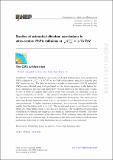Studies of azimuthal dihadron correlations in ultra-central PbPb collisions at √s[subscript NN] =2.76 TeV
Author(s)
Apyan, Aram; Busza, Wit; Cali, Ivan Amos; Chan, M.; Di Matteo, Leonardo; Gomez-Ceballos, Guillelmo; Goncharov, Maxim; Gulhan, Doga Can; Klute, Markus; Lai, Yue Shi; Ma, Teng; Paus, Christoph M. E.; Ralph, Duncan Kelley; Roland, Cristof E.; Stephans, George S. F.; Velicanu, Dragos Alexandru; Veverka, Jan; Wyslouch, Boleslaw; Yoon, A. S.; Zanetti, Marco; Paus, Christoph M. E.; Barbieri, Richard Alexander; Bauer, Gerry P; Dutta, Valentina; Lee, Yen-Jie; Levin, Andrew Michael; Luckey Jr, P David; Roland, Gunther M; Stoeckli, Fabian; Sumorok, Konstanty C; Yang, Mingming; Wyslouch, Victoria; Roland, Christof E; ... Show more Show less
DownloadChatrchyan-2014-Studies of azimuthal.pdf (1.588Mb)
PUBLISHER_CC
Publisher with Creative Commons License
Creative Commons Attribution
Terms of use
Metadata
Show full item recordAbstract
Azimuthal dihadron correlations of charged particles have been measured in PbPb collisions at √s[subscript NN] = 2.76TeV by the CMS collaboration, using data from the 2011 LHC heavy-ion run. The data set includes a sample of ultra-central (0-0.2% centrality) PbPb events collected using a trigger based on total transverse energy in the hadron forward calorimeters and the total multiplicity of pixel clusters in the silicon pixel tracker. A total of about 1.8 million ultra-central events were recorded, corresponding to an integrated luminosity of 120 μb − 1. The observed correlations in ultra-central PbPb events are expected to be particularly sensitive to initial-state fluctuations. The single-particle anisotropy Fourier harmonics, from v [subscript 2] to v [subscript 6], are extracted as a function of particle transverse momentum. At higher transverse momentum, the v [subscript 2] harmonic becomes significantly smaller than the higher-order v [subscript n] (n ≥ 3). The p [subscript T]-averaged [subscript v] 2 and [subscript v] 3 are found to be equal within 2%, while higher-order v [subscript n] decrease as n increases. The breakdown of factorization of dihadron correlations into single-particle azimuthal anisotropies is observed. This effect is found to be most prominent in the ultra-central PbPb collisions, where the initial-state fluctuations play a dominant role. A comparison of the factorization data to hydrodynamic predictions with event-by-event fluctuating initial conditions is also presented.
Date issued
2014-02Department
Massachusetts Institute of Technology. Department of Physics; Massachusetts Institute of Technology. Laboratory for Nuclear Science; Massachusetts Institute of Technology. School of ScienceJournal
Journal of High Energy Physics
Publisher
Springer-Verlag
Citation
Chatrchyan, S., V. Khachatryan, A. M. Sirunyan, A. Tumasyan, W. Adam, T. Bergauer, M. Dragicevic, et al. “Studies of Azimuthal Dihadron Correlations in Ultra-Central PbPb Collisions at √s[subscript NN] =2.76 TeV.” J. High Energ. Phys. 2014, no. 2 (February 2014). © CERN, for the benefit of the CMS Collaboration
Version: Final published version
ISSN
1029-8479
1126-6708